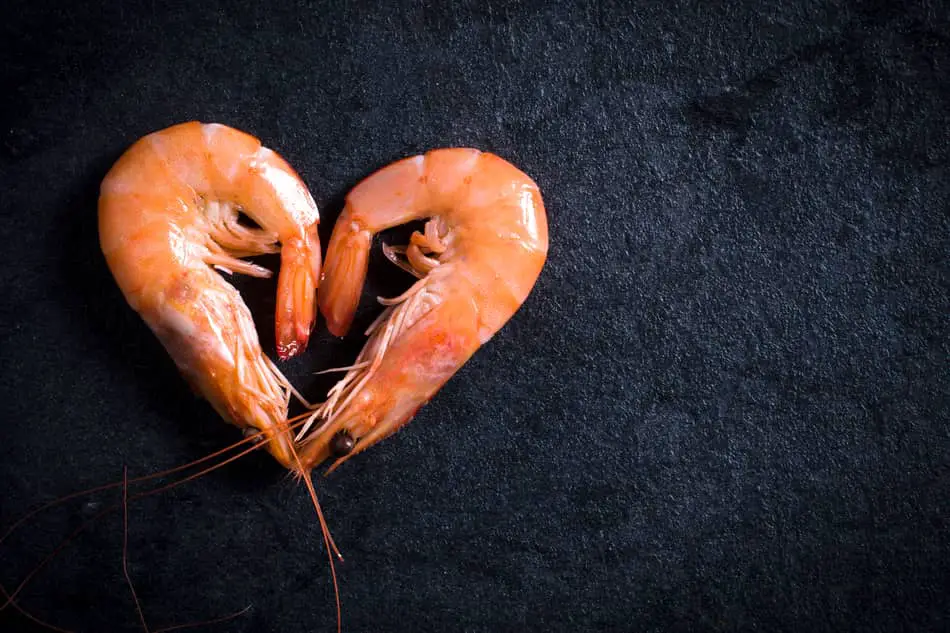I think this question comes from folks who’ve been influenced by authors like Peter Singer who at one point or another (I’m not sure what his thoughts are these days) condoned eating certain marine life—namely bivalves like oysters, clams, etc. as they’re thought to have very rudimentary nervous systems.
Can vegans eat shrimp? No, shrimp is 100% off-limits for vegans. For one, the consumption of bivalves never really had the green light from the vegan community at large. Secondly, even if oysters and the like were deemed appropriate for vegans, shrimp are not bivalves—they have much more sophisticated nervous systems.
Anyway, what we’ll do here is get into some of the reasons shrimp are not considered appropriate for vegans.
The Sentience of Shrimp
Shrimp Have a Relatively Complex Peripheral Nervous System
They have pain receptors and are thus thought to be capable of physical suffering. The peripheral nervous system is responsible for an organism’s response to harmful or potentially harmful stimuli.
Nociceptors are sensory receptors responsible for sensing painful stimuli, and their presence is one significant piece of evidence that an organism is capable of pain.
In nociception, mechanical and thermal stimulation of these sensory nerve cells produces a signal that travels through a chain of nerve fibers along the spinal cord to the brain.1
This process triggers a number of behavioral and physiological responses accompanied by a subjective experience of pain.2
All of these processes have been observed in shrimp and other crustaceans. The common brown shrimp, for example, has been shown to exhibit nociceptive sensitivity to extremes in temperature.
Further, it’s long been known that opiates modulate nociception in vertebrates. The popular pain killer morphine is an “analgesic” that’s very effective in ameliorating the sensation of pain. Anyway, opioid modulation of nociception has been shown in numerous invertebrate species.3
The first report of opiate effects in invertebrates is based on the behavioral responses of the crustacean mantis shrimp.
In fact, researchers demonstrated and confirmed opiate effects in invertebrates based on the behavioral responses of a certain type of mantis shrimp. They responded to an electric shock with an immediate, convulsive and violent, flexion of the body.
They were then injected with morphine-HCL, which produced dose-dependent analgesia increasing the shrimps’ intensity threshold to the shock.4
“Eyestalk ablation” is the term used for the removal of eyestalks from a crustacean. It’s used to treat female prawns in most marine shrimp reproduction or maturation facilities—used for commercial and research purposes.
The removal of eyestalks is used to stimulate the female shrimp to spawn and develop mature ovaries.5
In Macrobrachium americanum (the genus of freshwater prawns and shrimp), prawns treated with the local anesthetic, lignocaine, demonstrated fewer signs of discomfort (rubbing, sheltering, etc.) compared to those not administered the anesthetic.6
Shrimp Demonstrate Protective Responses
Only one study looking at protective responses in crustacean species showed a lack of response to noxious stimuli. In the study, white shrimp did not show any neural or behavioral changes after being exposed to various acids and bases.7
But, on balance, such studies show shrimp to exhibit a fairly strong response to painful stimuli. For example, one study showed the mantis shrimp to use a strong tail-flick “escape response” to avoid an electric shock.8
Ecological Concerns
Commercial fishing has numerous negative effects on the environment.
Deforestation
Vast swaths of mangrove forest are routinely destroyed in order to make way for shrimp ponds, which has a very detrimental effect on the coastal ecology of tropical nations.9
Seabed Destruction
Shrimp trawlers come outfitted with a number of attachments like ‘tickler chains’ which drag along the seabed out in front of the net. This dragging along the bottom disturbs the benthic sediments causing the bottom-dwelling organisms like shrimp to move into the mouth of the trawl.10
So, this attachment causes a great disturbance to the seabed as part of its design.
The nets drag tens of thousands of kilograms of mud, rocks, and marine organisms for miles along the bottom causing great damage.11
Then there’s “multi-rig trawling.” In this setup, trawl nets are pulled along behind fishing boats, in pairs of two or more.12
Multiple trawl nets increase the amount of shrimp caught per unit of effort (CPUE) but, of course, also increases the environmental impacts of trawling through the roof.
Impacts Shrimp Trawling on Benthic Environments
We, vegans, are against all forms of fishing. But, shrimping is especially egregious when it comes to disturbing benthic environments. So you know, the benthic zone is the ecological region at the very bottom of a body of water like ocean, stream, or lake and includes the sediment surface and sub-surface layers.
Traditional large-scale commercial fishing modifies the benthic (seabed) habitats, but their impacts are nothing compared to the disruption caused by commercial trawlers. Shrimp trawling affects benthic fauna, diversity, habitat, and community structure in both temperate and tropical seas.13
Trawling nets, with their attachments, are made to really maximize contact with the seabed, crushing, grinding, exposing, and burying marine animals.11
It’s what they’re made to do.
The trawling process churns up and re-suspends bottom sediments, along with any toxic chemicals they contain. Over time, the seabed is smoothed over by the trawlers, destroying the structural diversity it needs to serve as a habitat for the range of marine organisms that inhabit it.13
Dr. Peter Auster, the Science Director at the National Undersea Research Center for the North Atlantic and Great Lakes (NURC-NA&GL—a mouthful, I know), has argued for a long time that the structural complexity of habitats is critical for many marine species and provide cover for fish from their prey, including shrimp, crab, marine worms, and starfish.14
Bycatch
Bycatch is defined as “the difference between what a fisherman looks for principally, and what he manages to catch in reality.”15
Most fisheries tend to be unselective when it comes to the species they ensnare. While they aren’t trying to catch non-target marine life, they catch all manner of sea critters along with the marine species they’re targeting. Fish species make up the majority of bycatch—one prawn trawl fishery’s catchings were shown to be 69% fish (by weight).16
Round fish like cod, pollock, hake, croakers, snappers, and groupers are the most prone to mortality because their large swim/air bladders rupture and burst when removed from the high-pressure sea-floor.17
Reptiles, like turtles and sea snakes, breath air making them very vulnerable to drowning when caught in nets and pulled along underwater. Marine organisms other than fish tend to die from physical damage and stress in the time it takes for them to be sorted and released.
Research into two different shrimp fisheries in Australia found almost all of the discarded bycatch to be returned dead or at the point of death, where at best they serve as a potential food source for scavengers like seabirds.18
The end result is that the death and waste of these species is equivalent to them having been directly fished as target species in the first place.18
This has been going on for decades. A 1996 FAO report containing a global assessment of fisheries bycatch and discards, stated: “there is a growing body of evidence clearly demonstrating the serious character of discarding bycatch of various marine populations, including some fishes, marine mammals and turtles.”19
Shrimp trawling is no exception, and in fact, is one of the worst offenders. With its large nets made of fine-mesh dragging along the sea bed for miles, it results in much more bycatch than other forms of fishing—bycatch that tends to be dead, wasted and discarded over the side of the vessel.
Most of the bycatch is already dead when discarded, or at the very least unlikely to survive once tossed back in the ocean.16
Shrimp trawlers are responsible for a much higher proportion of ensnared non-target marine life compared to other fishery types, making up one-third of the total bycatch waste globally.20
This is despite the fact that shrimp fisheries produce a mere 1-2% of global seafood.21
Both the amount and types of species commonly found in shrimp trawl nets depends on the depth and the characteristics of the seabed.18
And it’s not heavily regulated. Few shrimp fisheries actually monitor their bycatch regularly or pay much attention to how the amount caught changes over time.
Anyway, I hope I helped dissuade you of the notion that vegans can eat simple marine life. Vegetarianism takes many forms, and certain vegetarians known as pescatarians are permitted to eat fish. You can read more about the different types of plant-based diets in the article I wrote comparing and contrasting them. Check it out here. But, while suitable for some vegetarians, vegans, especially ethical vegans should refrain from all forms of meat consumption.
References
- Portenoy, Russell K.; Brennan, Michael J. (1994). “Chronic Pain Management”. In Good, David C.; Couch, James R. (eds.). Handbook of Neurorehabilitation. Informa Healthcare. ISBN 978-0-8247-8822-3.
- “Assessing Pain and Distress: A Veterinary Behaviorist’s Perspective by Kathryn Bayne”. Definition of Pain and Distress and Reporting Requirements for Laboratory Animals. Proceedings of the Workshop Held June 22, 2000. 2000.
- Nieto-Fernandez, F., Andrieux, S., Idrees, S., Bagnall, C., Pryor, S.C. and Sood, R. (2009). “The effect of opioids and their antagonists on the nocifensive response of Caenorhabditis elegans to noxious thermal stimuli”. Invertebrate Neuroscience. 9 (3–4): 195–200.
- Maldonado, H. & Miralto, A. (1982). “Effect of morphine and naloxone on a defensive response of the mantis shrimp (Squilla mantis)”. Journal of Comparative Physiology. 147 (4): 455–459.
- Uawisetwathana, Umaporn; Leelatanawit, Rungnapa; Klanchui, Amornpan; Prommoon, Juthatip; Klinbunga, Sirawut; Karoonuthaisiri, Nitsara (2011). “Insights into Eyestalk Ablation Mechanism to Induce Ovarian Maturation in the Black Tiger Shrimp”. PLoS ONE. 6 (9): e24427.
- Diarte-Plata, G., Sainz-Hernández, J.C., Aguiñaga-Cruz, J.A., Fierro-Coronado, J.A., Polanco-Torres, A. and Puente-Palazuelos, C. (2012). “Eyestalk ablation procedures to minimize pain in the freshwater prawn Macrobrachium americanum”. Applied Animal Behaviour Science. 140 (3): 172–178.
- Puri, S. & Faulkes, Z. (2010). “Do decapod crustaceans have nociceptors for extreme pH?”. PLOS ONE. 5 (4): e10244.
- Maldonado, H.; Miralto, A. (1982). “Effects of morphine and naloxone on a defensive response of the mantis shrimp (Squilla mantis)”. Journal of Comparative Physiology A. 147 (4): 455–459.
- Squandering the Seas: How Shrimp Trawling Is Threatening Ecological Integrity and Food Security Around the World: a Report Environmental Justice Foundation – 2003
- McQuaid, J. 1997. Trawling into trouble. The Times-Picayune. http://www.pulitzer.org
- Watling, L. and Norse, E. 1998b. Disturbance of the Seabed by Mobile Fishing Gear: A Comparison to Forest Clearcutting. Conservation Biology, Vol 12(6) pp1180-1197.
- Stephan, C. et al. 2000. Evaluating fishing gear impacts to submerged aquatic vegetation and determining mitigation strategies. ASMFC Habitat Management Series #5, ASMFC, Washington DC
- Jennings, S. and Kaiser, M. 1998. The effects of fishing on marine ecosystems. Advances in Marine Biology, 34: 201-352.
- Auster, P. 1998. Scientists speak on bottom trawling. American Ocean Alliance.
- Serge Garcia, Food and Agriculture Organisation of the United Nations: personal communication.
- Hill, B. and Wassenberg, T. 2000 The probable fate of discards from prawn trawlers fishing near coral reefs study in the northern Great Barrier Reef, Australia. Fisheries Research Vol. 48, no.3, pp227- 286 (10).
- Clucas, I. 1997. A study of the options for utilisation of bycatch and discards from marine capture fisheries. Food and Agriculture Organisation of the United Nations, Rome.
- Stobutzki, I. et al. 2001. Bycatch diversity and variation in tropical Australian penaeid fishery: the implications for monitoring. Fisheries Research 53 pp283-301.
- FAO 2002b. Globefish Commodity Update: Shrimp. Food and Agriculture Organisation of the United Nations, Rome.
- Alverson, D. et al. 1996. A global assessment of fisheries bycatch and discards. FAO Fisheries technical paper 339, Food and Agriculture Organisation of the United Nations, Rome.
- Hall, M. et al. 2001. Chapter 116: Bycatch: Problems and solutions in Sheppard, C. (ed) Seas at the Millennium: An Environmental Evaluation. Elsevier Science, Ltd.

